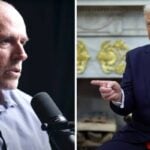We adhere to strict standards of editorial integrity to help you make decisions with confidence. Some or all links contained within this article are paid links.
In a stunning reversal of policy, President Donald Trump slashed “Liberation day” tariffs on China from 145% to 30% for 90 days as of May 14.
The landmark agreement between the world’s two largest economies has gained traction — erasing the stock market’s losses in the wake of “Liberation day” tariffs in early April.
While negotiations are still ongoing, U.S. Treasury Secretary Scott Bessent said that the goal is to drive strategic decoupling between the two superpowers.
“We do not want a generalized decoupling from China,” Bessent said during an interview with CNBC.
“But what we do want is a decoupling for strategic necessities, which we were unable to obtain during Covid and we realized that efficient supply chains were not resilient supply chains.”
Don’t miss
- I’m 49 years old and have nothing saved for retirement — what should I do? Don’t panic. Here are 6 of the easiest ways you can catch up (and fast)
- Robert Kiyosaki warns of a ‘Greater Depression’ coming to the US — with millions of Americans going poor. But he says these 2 ‘easy-money’ assets will bring in ‘great wealth’. How to get in now
- Gain potential quarterly income through this $1B private real estate fund — even if you’re not a millionaire. Here’s how to get started with as little as $10
However, industry-specific tariffs remain in place. This is part of Trump’s greater push to revive the country’s manufacturing sector.
“We are going to create our own steel. [Tariffs] protect our steel industry. They work on critical medicines, on semiconductors,” Bessent said “We are doing that, and the reciprocal tariffs have nothing to do with the specific-industry tariffs.”
But affordability remains one of the biggest concerns for Americans. The average tariff rate on imports stands at 17.8% — the highest since 1934. This is expected to cost median households in the U.S. approximately $2,800, according to a recent Yale Budget Lab report.
However, Bessent argues that affordability isn’t just about cheap imports — it’s about ensuring Americans can build real financial security.
“What I’m saying is the American dream is not ‘let them eat flat screens,’” Bessent noted during an appearance on NBC’s Meet the Press.
“If American families aren’t able to afford a home, don’t believe that their children will do better than they are [doing], the American dream is not contingent on cheap baubles from China, it is more than that. And we are focused on affordability, but it’s mortgages, it’s cars, it’s real wage gains.”
Read more: Want an extra $1,300,000 when you retire? Dave Ramsey says this 7-step plan ‘works every single time’ to kill debt, get rich in America — and that ‘anyone’ can do it
Housing affordability remains a pressing issue
Bessent’s remarks highlight one of the most pressing financial issues for Americans today: the soaring cost of homeownership.
Over the last decade, U.S. home prices have surged, with the S&P CoreLogic Case-Shiller U.S. National Home Price Index nearly doubling. Federal Reserve Chair Jerome Powell has acknowledged the severity of the problem, pointing to supply constraints as a key driver.
“The real issue with housing is that we have had, and are on track to continue to have, not enough housing,” Powell said at a press conference in September. He explained that “all aspects of housing” face challenges, including the zoning of land in desirable locations.
“Where are we going to get the supply?” he asked.
The gap between supply and demand is significant. An analysis by Zillow in June estimated the U.S. housing shortage at 4.5 million homes as of 2022.
There’s also the issue of high mortgage rates, which stand at around 6.67%, meaning borrowing money to buy a home remains expensive.
If you’re in the market for a home, Freddie Mac recommends shopping around by obtaining quotes from three to five lenders to secure the best mortgage rate possible. Even a small rate reduction can translate into significant savings over the life of a loan.
To make this process easier, platforms like the Mortgage Research Center (MRC) can help you quickly compare rates and estimated monthly payments from multiple vetted lenders. By entering basic details — such as your zip code, property type, price range and annual income — you can view mortgage offers tailored to your needs and shop with confidence.
Rising cost of car ownership
Bessent also pointed to cars as part of America’s affordability issue. Even though pandemic-induced supply chain disruptions and chip shortages have eased, the cost of owning a car remains high.
According to the American Automobile Association (AAA), the total cost of owning and operating a new vehicle in 2024 has climbed to around $12,297 per year — or $1,024.71 per month.
One major recurring expense is car insurance, and many people overpay without realizing it. According to Forbes, the national average cost for full-coverage car insurance in 2024 was $2,149 per year (or $179 per month). However, rates can vary widely depending on your state, driving history and vehicle type.
By using OfficialCarInsurance.com, you can easily compare quotes from multiple insurers, such as Progressive, Allstate and GEICO, to ensure you’re getting the best deal.
In just two minutes, you could find rates as low as $29 per month.
Find additional sources of capital
With home values higher than ever, you can make your home work harder for you by making the most of your equity. The average homeowner sits on roughly $311,000 in equity as of the third quarter of 2024, according to CoreLogic.
Having access to your home equity could help to cover unexpected expenses, pay substantial debt, fund a major purchase like a home renovation or supplement income from your retirement nest egg.
Rates on HELOCs and home equity loans are typically lower than APRs on credit cards and personal loans, making it an appealing option for homeowners with substantial equity.
Unlock great low rates in minutes by shopping around. You can compare real loan rates offered by different lenders side-by-side through LendingTree.
Just answer a few simple questions, and LendingTree will match you with up to 5 lenders 1 with low rates today.
What to read next
- JPMorgan sees gold soaring to $6,000/ounce — use this 1 simple IRA trick to lock in those potential shiny gains (before it’s too late)
- This is how American car dealers use the ‘4-square method’ to make big profits off you — and how you can ensure you pay a fair price for all your vehicle costs
- Here are 5 ‘must have’ items that Americans (almost) always overpay for — and very quickly regret. How many are hurting you?
- How much cash do you plan to keep on hand after you retire? Here are 3 of the biggest reasons you’ll need a substantial stash of savings in retirement
Like what you read? Join 200,000+ readers and get the best of Moneywise straight to your inbox every week. Subscribe for free.
- Terms and Conditions apply. NMLS# 1136
This article provides information only and should not be construed as advice. It is provided without warranty of any kind.





